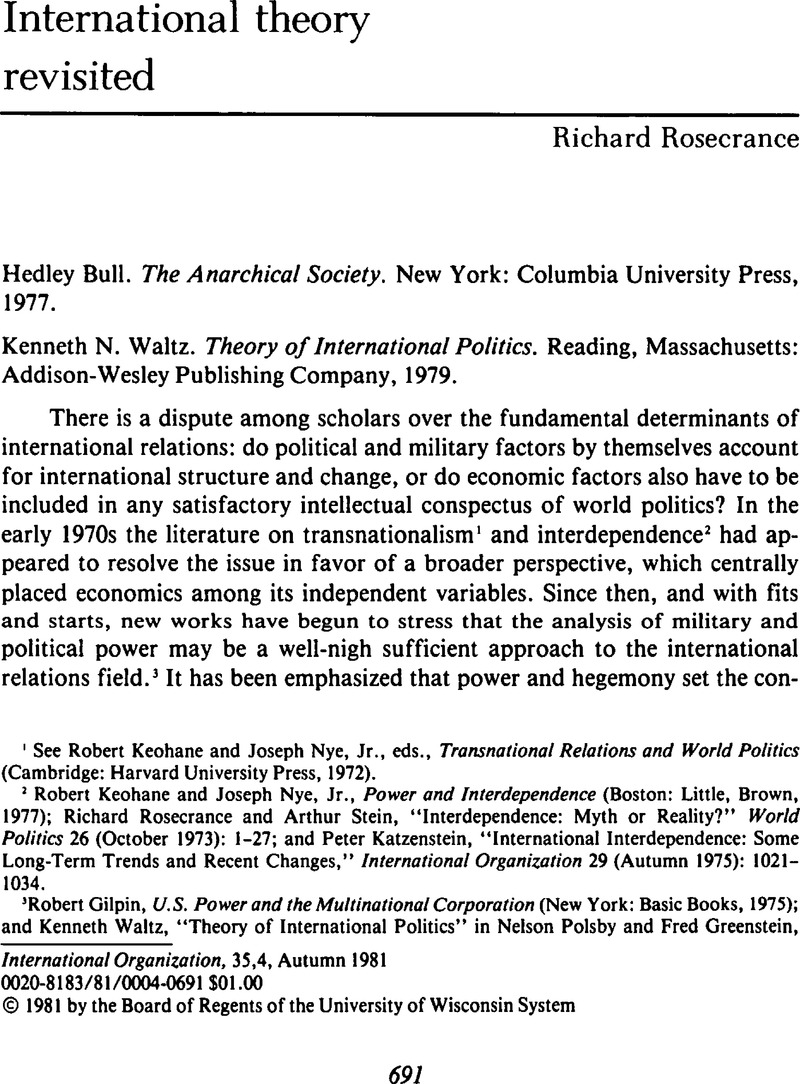Published online by Cambridge University Press: 22 May 2009

1 See Keohane, Robert and Nye, Joseph Jr, eds., Transnational Relations and World Politics (Cambridge: Harvard University Press, 1972)CrossRefGoogle Scholar.
2 Keohane, Robert Jr and Nye, Joseph Jr, Power and Interdependence (Boston: Little, Brown, 1977)Google Scholar; Rosecrance, Richard and Stein, Arthur, “Interdependence: Myth or Reality?” World Politics 26 (10 1973): 1–27CrossRefGoogle Scholar; and Katzenstein, Peter, “International Interdependence: Some Long-Term Trends and Recent Changes,” International Organization 29 (Autumn 1975): 1021–1034CrossRefGoogle Scholar.
3 Gilpin, Robert, U.S. Power and the Multinational Corporation (New York: Basic Books, 1975)CrossRefGoogle Scholar; and Waltz, Kenneth, “Theory of International Politics” in Polsby, Nelson and Greenstein, Fred, eds., Handbook of Political Science, vol. 8: International Politics (Reading, Mass.: Addison-Wesley, 1975), pp. 1–86Google Scholar.
4 See particularly the forthcoming number of International Organization, edited by Stephen Krasner, on international regimes.
5 See Ruggie, John G. on technological regimes in “International Responses to Technology: Concepts and Trends” (esp. pp. 570–73), International Organization 29 (Summer 1975)CrossRefGoogle Scholar, and Keohane and Nye on territorial and economic regimes in Power and Interdependence. But the independent-variable structure of both arguments remains vague.
6 As a landmark in the shift see particularly Knorr, Klaus and Rosenau, James, eds., Contending Approaches to International Politics (Princeton: Princeton University Press, 1967)Google Scholar.
7 Reductionism is like the so-called “naturalistic fallacy” in ethics. It may well be proved to be an error, but it cannot stand as a fallacy. It is quite possible that the major causes of international transformation, stability, and unstability lie outside the formal system. The French Revolution was a unit-level phenomenon and yet its systemic effects in terms of power, ideological conflicts, and nationalism have been greater than Waltz's vaunted manipulations of power and number. Power in any event is largely determined by domestic, and thus unit-level and reductionist, influences. See in addition Hoffmann, Stanley, Primacy or World Order (New York: McGraw-Hill, 1978), p. 146Google Scholar.
8 See, for example, Morgenthau, Hans J., In Defense of the National Interest (New York: Alfred A. Knopf, 1952), chap. 1Google Scholar, and Politics among Nations, 2nd ed. (New York: Alfred A. Knopf, 1956), chap. 17Google Scholar.
9 Krasner's account of mutually reinforcing influences is useful here. Stephen Krasner, “Introduction: International Regimes and Structural Constraints” (International Organization, forthcoming).
10 This conclusion is modified in favor of bipolarity in chap. 8.
11 See pp. 151–58.
12 He points out early in the argument that theories can be expected to hold only if their conditions are approximated, and the “theory, as a generally explanatory system, cannot account for particularities” (p. 118).
13 Though it is not stressed by Waltz, interdependence between the two great powers in a bipolar world must be very high. Their interests are even more mutually contingent than the interest of five powers in a multipolar world.
14 See Organski, A. F. K., World Politics, 2nd ed. (New York: Alfred A. Knopf, 1968)Google Scholar.
15 See Rosecrance and Stein, “Interdependence: Myth or Reality,” and Edward L. Morse, “Transnational Economic Processes,” in Keohane and Nye, Transnational Relations and World Politics.
16 See, for comparison, Cooper, Richard, “Natural Resources and National Security” in The Middle East and the International System, vol. 2: Security and the Energy Crisis, Adelphi Paper no. 1S5 (London: International Institute for Strategic Studies, 1975)Google Scholar.
17 There are in fact two trends: one charts the power and number of the great powers, the other the power and number of states as a whole. Among great powers bipolarity was the first system and it (though lesseningly) remains the last. Among ordinary powers, the trend was toward decline in numbers until World War I, and after World War II a massive increase.
18 It is argued above that the two leading powers did not have to become enemies. When they did become enemies, however, the bipolarity that followed was by no means necessarily stable.
19 These statements accept the structural perspective as given. In fact detente has been conditioned and determined as much by nonstructural, and in Waltz's terms reductive, factors as by system structure.